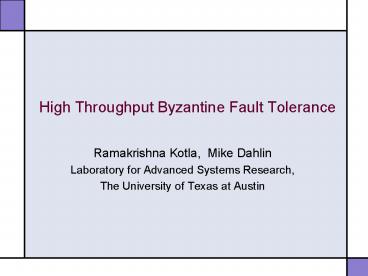High Throughput Byzantine Fault Tolerance - PowerPoint PPT Presentation
Title:
High Throughput Byzantine Fault Tolerance
Description:
Laboratory for Advanced Systems Research, The University of Texas at Austin ... High Security : Data integrity/Confidentiality. High Throughput : System load ... – PowerPoint PPT presentation
Number of Views:74
Avg rating:3.0/5.0
Title: High Throughput Byzantine Fault Tolerance
1
High Throughput Byzantine
Fault Tolerance
- Ramakrishna Kotla, Mike Dahlin
- Laboratory for Advanced Systems Research,
- The University of Texas at Austin
2
Summary of the talk
- High throughput is achievable along with
Byzantine fault tolerance - Contributions
- High Throughput BFT Architecture
- CBASE Generic Prototype
- CBASE-FS High throughput replicated NFS
3
Outline
- Overview
- Architecture
- Implementation
- Evaluation
- Conclusion
4
Motivation
- Large scale Internet services
- High Availability 24 X 7 service
- High Reliability Correctness
- High Security Data integrity/Confidentiali
ty - High Throughput System load
- Challenges Byzantine failures
- Malicious attacks
- http//www.cert.org
- Software and operator errors
- ROC_at_USITS03
- Network and hardware failures
5
BFT State Machine Replication
6
BFT state machine replication
- Byzantine Fault Tolerance Protocol
- Tolerates f Byzantine server failures using 3f1
replicas - Agreement Order requests from clients
- Execution stage Execute requests
- Provide high availability, reliability and
security - PBFT, Farsite, Oceanstore OSDI99, OSDI01,
SOSP01, SOSP03
7
BFT Tradeoff throughput for fault tolerance ?
8
Traditional BFT Limitations
- Fail to provide high throughput
- Does not scale with hardware resources and
application parallelism - Reason
- Uses Generalized State Machine Replication
- Correctness conditions
- Agreement Every non-faulty state machine
replica receives every request - Order Every non-faulty state machine replica
processes the requests in the same relative order - BFT State machine replication
- Execute requests sequentially to ensure order
9
High Throughput BFT Idea
- Modify Order without compromising
consistency/safety - Relaxed order Every non-faulty replica executes
dependent requests in the same relative order - Dependent requests Two requests are dependent
if read set or write set of one intersects with
write set of the other. - Requests that are not dependent can be
concurrently executed - Exploit application parallelism to provide high
throughput - Commercial applications like web server, file
systems, databases have inherent data parallelism
10
Outline
- Overview
- Architecture
- Implementation
- Evaluation
- Conclusion
11
HT BFT Architecture
- Goals
- Generic Generic interface that exposes
application parallelism - Extensible Easily extensible to support any
application - Modular Support different fault models easily
- Reuse Reuse existing agreement protocols
Server Replicas
Execution
Execution
Execution
Execution
Parallelizer
Parallelizer
Parallelizer
Parallelizer
Agreement
Agreement
Agreement
Agreement
12
Parallelizer
- Application independent module
- Receives ordered requests from agreement
- Maintains/Updates dependency graph of requests
- 2 level dependency analysis
- Concurrency matrix
- Schedules a request if it is not dependent on any
outstanding requests (no outgoing edges at a
request node) - Requests that are not dependent are concurrently
executed
13
Parallelizer Concurrency Matrix
- Definition/Figure Square matrix rows/columns
represent operations - 1 represents independent, 0 represents dependent
operations - Exports application level parallelism
- Statically defined
- Two matrices Dependency also depends on objects
- Related objects
- Unrelated objects
- Table Lookup
- Low overhead
14
Parallelizer Dependence Analysis
- Parallelizer figure agreement stage, input
queue, dependency graph, multi thread execution
stage
15
Advantages/Limitations
- Advantages
- Supports high throughput applications
- Simple Minimal/No changes to client/agreement
protocol/application - Flexible Supports different fault models easily
- Limitation
- Concurrency matrix requires inner workings of
application - Conservative rules ensures correctness at the
expense of performance - Incrementally refine the rules to gain performance
16
Outline
- Overview
- Architecture
- Implementation
- Evaluation
- Conclusion
17
System Model
- Asynchronous system
- Nodes operate at arbitrarily different speeds
- Network may delay, drop or deliver messages out
of order - Assumption Bounded fair links
- Fault Model Byzantine Faults
- Faulty nodes may behave arbitrarily crash,
lose/alter data, send incorrect messages - Adversary Strong adversary
- Can coordinate faulty nodes in arbitrarily bad
ways - Assumption Computationally limited
18
CBASE Concurrent BASE
- Uses unmodified PBFT agreement protocol OSDI
1999 - Built upon BASE library SOSP 2001
- Agreement stage Single thread
- Execution stage Multithreaded
- Parallelizer Producer/Consumer queue
- Figure ??
19
Parallelizer Interface
- Parallelizer.insert()
- Parallelizer.next_request()
- Parallelizer.sync()
20
CBASE-FS BFT NFS
- Figure
- Brief description of NFS concurrency matrix rules
- Related objects Same NFS handle
- Rules are conservative
- Refer paper for more details
21
Outline
- Overview
- Architecture
- Implementation
- Evaluation
- Conclusion
22
Evaluation
- With 4 server replicas that tolerate 1 Byzantine
failure - Replicas running on different uniprocessor
machine - 933 MHz P3, 256 MB Ram
- 5 Client machines
- Dedicated network with 100MB ethernet hub
- OS Redhat Linux 7.2 with NFS 2.0
- Assumption No correlated failures due to OS.
23
Microbenchmark Overhead
- BASE versus CBASE
24
Microbenchmark Scalability
- Scalability with hardware resources
- Scalability with application level parallelism
25
Microbenchmark CBASE-FS/BASE-FS/NFS
- Latency versus Throughput with no sleep
- Latency versus Throughput with 20 ms sleep
- Iozone results summary
26
Macrobenchmarks
- Postmark
- Andrew
27
Conclusions
- Commercial applications have parallelism
- High throughput BFT provides a simple/flexible
solution to achieve high throughput
28
Questions ?
- Why dont you have parallelizer in the agreement
stage to reduce agreement cost ?

